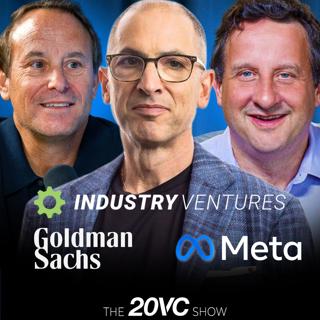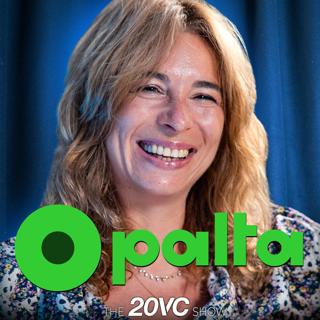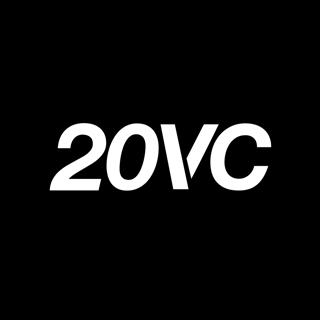
20VC: The Startup Adding $1M ARR Every Week | Competing Against OpenAI's Codex and Claude Code: Who Wins | Why Gemini is Failing and GPT-5 Is Winning | Do Margins Matter in a World of AI | The Ugly Truth About AI Coding with Zach Lloyd, Warp
Zach Lloyd is the Founder and CEO of Warp, the next-generation developer terminal reinventing how engineers build and collaborate. Warp has raised over $70M from top-tier investors including Sequoia Capital, GV, Dylan Field, and Elad Gil. Before founding Warp, Zach was Principal Engineer at Google, where he led development of Google Docs, and later served as CTO at Time. He's one of the most respected engineering minds redefining the future of developer tools. AGENDA: 04:14 Biggest Product Lessons from Rewriting Google Sheets 07:10 Why I Would Short Google: Leadership and AI Strategy 09:55 Comparing AI Models: GPT, Claude, and Gemini: Who Wins and Loses 17:04 Do Margins Matter in AI? 24:57 Adding $1M in ARR Every Week: Is Triple, Triple, Double, Double Dead? 33:58 How to Build Defensibility in a World of AI? 43:05 OpenAI vs Anthropic: Who Wins and Why? 44:25 Biggest Fundraising Lessons Raising from Sequoia, Elad Gil and GV 50:56 Why Sequoia are the Best VC 53:51 What Every Founder Gets Wrong in Fundraising 01:01:30 Quick Fire Questions and Final Thoughts
17 Okt 1h 13min

20VC: $3.5BN - The Price Zuck Paid for Thinking Machines Co-Founder | Goldman Sachs Acquires Industry Ventures for $665M | Softbank Borrows $5BN Against ARM Holding to Invest More Into OpenAI
AGENDA: 03:44 Rory Is So Old He Worked with Arthur Rock!!! 07:28 Goldman Sachs Acquires Industry Ventures for $665M 16:37 Thinking Machines Co-Founder Raises $2BN and Then Leaves for Meta 29:36 SoftBank Goes for $5BN Leverage Against ARM Stock To Buy More OpenAI 39:35 More Data Centres Than Offices: Are We In a Bubble 43:28 Where is the Alpha in Venture in 2025 51:48 What 90% of Managers Get Wrong About Portfolio Management
16 Okt 1h 19min

20VC: Atlassian CEO on Why Everything is Overvalued & Are We in an AI Bubble | Do Margins Matter & Does Defensibility Exist in an AI World | Is Per Seat Pricing Dead & The Future of Vibe Coding with Mike Cannon-Brookes
Mike Cannon-Brookes is the Co-Founder and Co-CEO of Atlassian, the $50BN software giant behind products like Jira, Confluence, and Trello. Since founding the company in 2002, he has scaled it to over 300,000 customers globally, generating more than $5BN in annual revenue. Atlassian now employs over 10,000 people across 13 countries and is one of the most successful bootstrapped-to-IPO stories in tech history. Mike is also a leading climate investor and co-owner of several major sports teams. AGENDA: 00:00 Why Unreasonable Men Win in Startups 07:22 How to Make Co-CEOs Work 13:22 Are We in an AI Bubble? Is Everything Overvalued? 26:46 The Future of Software Development: More or Less Devs 32:53 Do Margins Matter in a World of AI 34:02 The Future of Vibe Coding… 36:35 Does Defensibility Exist in a World of AI 42:09 Is Per Seat Pricing Dead in a World of AI 49:01 The Founder Journey and Leadership 54:28 Quick Fire Round: Parenting Advice, Relationship to Money
13 Okt 1h 3min

20Sales: Scaling Snowflake from $0-$3BN in ARR | Snowflake vs Databricks: My Biggest Lessons | Why Customer Success is BS and What Replaces It with Chris Chris Degnan
Chris Degnan is the former Chief Revenue Officer at Snowflake, where he was instrumental in scaling the company from less than $1M in ARR to over $3B in annual revenue. He joined as the first sales hires and built Snowflake's go-to-market engine from scratch, growing the team from to more than 6,000 globally. Under his leadership, Snowflake became one of the fastest-growing enterprise software companies in history, achieving a record-breaking IPO in 2020. AGENDA: 04:34 How to Build a Sales Team from Scratch 07:49 How to Hire and Evaluate Sales Leaders 15:23 Four Big Lessons Scaling Snowflake to $3BN ARR 31:30 Comparing Snowflake and Databricks: What Databricks Did Better? 35:26 How to Manage Sales Team Morale in Competitive Markets 43:53 Why Customer Success is BS and What To Do With It 48:31 How Every Sales Leader Needs to Change in An AI World 49:37 Biggest Reflections on Sales Leadership 54:38 Quick Fire Questions and Final Thoughts 20Sales: Scaling Snowflake from $0-$3BN in ARR | Snowflake vs Databricks: My Biggest Lessons | Why Customer Success is BS and What Replaces It with Chris Chris Degnan
10 Okt 1h 2min

20VC: OpenAI's Multi $BN Deal with AMD | Polymarket, Vercel and Supabase Raise Mega Rounds | Does King Making Really Work in Venture Capital: Harvey vs Legora | Chamath is Back: The SPAC is Back
AGENDA: 03:29 OpenAI and AMD's Major Partnership 07:35 Microsoft Have F***** Up the OpenAI Partnership 17:08 OpenAI's Developer Day Announcements 20:45 Why VC is the Most Forgiving Asset Class on Price and Valuation 29:10 What Does it Take to IPO in 2025: Why Snyk Will Not IPO 42:30 Four Strategies Companies Need to Take to Own Their Own Destiny 49:31 Vercel Raises $300M at $9BN: Suicide Round or Strategic 55:39 Does King Making Really Work in Venture Capital: Legora vs Harvey 01:08:11 Chamath Raises Latest SPAC: SPACs are Back 01:10:56 Polymarket Raises $2BN at a $9BN Valuation 01:14:53 Quick Fire Questions and Wrap-Up
9 Okt 1h 24min

20VC: Cerebras CEO on Why Raise $1BN and Delay the IPO | NVIDIA Showing Signs They Are Worried About Growth | Concentration of Value in Mag7: Will the AI Train Come to a Halt | Can the US Supply the Energy for AI with Andrew Feldman
Andrew Feldman is Co-Founder & CEO of Cerebras, building the world's fastest AI inference and training. Cerebras recently closed a $1.1BN Series G round at an $8.1 billion valuation, backed by top names including Fidelity, Atreides, Tiger Global, Valor Equity and 1789 Capital. Under his leadership, they've leapfrogged GPU limits in inference, operate at trillions of tokens per month, and are filing to go public soon. AGENDA: 02:43 Why We Did Not IPO and Raised $1BN From Fidelity 05:03 Analysis of Chip and Compute Landscape Today 07:14 NVIDIA Showing Signs They Are Running Out of Ideas 13:57 The Real Questions to Ask on Chip Depreciation 24:54 Energy Requirements for AI: Is it Feasible? 29:25 Mag7 Value Concentration: Feature or a Bug 31:57 Talent is the Bottleneck and Trump Makes it Worse 32:55 The War for Talent: Secrets No One Sees 34:22 Evaluating the Data Centre Economy: Many Will Lose Money 38:01 Three Changes the US Could Make to Beat China in AI 42:30 Why 80% of our Revenues are in the UAE 47:26 Quick Fire Questions 58:59 Why Work Life Balance is Total BS
6 Okt 1h 4min

20Growth: How to Use Influencers to Scale Growth Insanely Fast | How to Optimise User Onboaring for Growth | How the Best Growth Teams Create Organic Growth and Community | Why LTV/CAC Models are BS with Ketty Slonimsky
Ketty Slonimsky is Chief Growth Officer at Palta, the platform behind apps like Flo (the #1 female health app with 77M+ MAU), Simple, and Zing AI, where she leads a centralized growth function across the portfolio. She was previously first VP Product & Growth at HeliosX (£900M+ ARR, bootstrapped D2C healthtech), has advised companies like SonderMind, Runna, Guardio, Cheddar, P&G Digital Ventures, and is a board advisor at HeliosX. AGENDA: 02:33 What is Growth and When to Hire For It 06:04 Three Profiles of Successful Growth Leaders 10:07 Challenges and Learnings from Failed Ventures 21:17 How to Optimise User Onboarding for Growth 26:14 Biggest Lessons on Retention 30:25 How to Artificially Create Organic Growth and Community Building 32:10 Why LTV Models are BS 37:35 How to Use Influencers to Grow Insanely Fast 47:07 The Metrics that Matter in Growth 49:48 Push Notifications and Engagement: What To Do vs What Not to Do? 51:57 Quick Fire Round
3 Okt 1h

20VC: Are Burn Multiples BS in an AI World | Sam Altman Needs $1TRN of Energy | Klarna, Figma, Stubhub, all Down: Are Public Markets Turning? | FiveTran and DBT: Is the Wave of Consolidation About to Begin?
AGENDA: 03:58 Understanding Burn Multiples and Capital Efficiency in an AI World 11:54 What Metrics Founders Need to Focus on in a World of AI 19:31 The Role of Kingmakers in Venture Capital: Harvey, Abridge, Profound 33:42 Klarna, Figma, Stubhub, all Down: Are Public Markets Turning? 36:35 OpenAI Needs the Same Energy as Japan… WTF! 41:09 How Can We Fund the $1TRN Sam Altman Needs for Energy 52:39 FiveTran and DBT: Is the Wave of Consolidation About to Begin? 59:44 Does Private Equity Need to Change in a World of AI 01:06:23 Political Expression and Corporate Responsibility
2 Okt 1h 16min






















